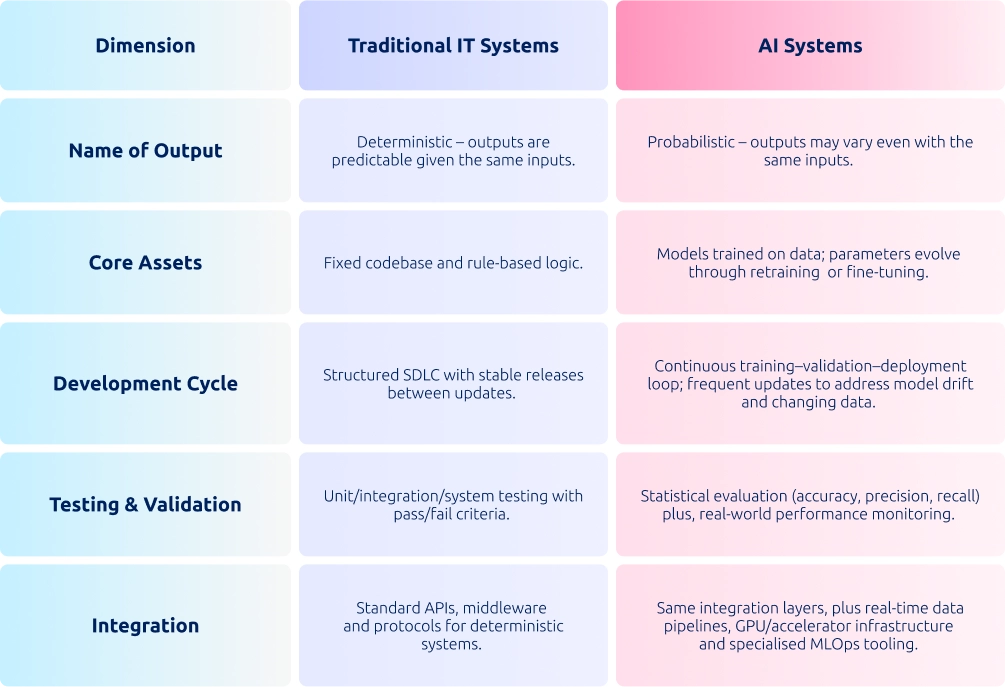Published: Oct 17, 2025
Overview of NCS Accelerators
Setting the standard for resilient, intelligence-driven operations
AI is no longer experimental. The challenge now is deploying it quickly, reliably, and at scale in mission-critical environments. For many IT leaders, AI rollouts feel both familiar and unfamiliar. Like IT systems, they require integration with existing infrastructure, rigorous testing, effective change management, and robust security controls. Yet there are differences, and this article will elaborate on what they are and why NCS has built a library of AI Accelerators: reusable, configurable components that help organisations deploy AI with the same discipline as IT systems, but optimised for AI’s unique demands.
Key takeaways
- AI is different from IT: AI systems are probabilistic and require continuous learning and governance.
- NCS has created six accelerators that mirror human cognitive functions: perception, language, movement, awareness, memory, and decision-making.
- Reusable and scalable: Each accelerator is pre-tested, configurable, and designed for enterprise deployment.
- Proven impact: An NCS client achieved a 54% reduction in after-call work and a 25% increase in daily call handling capacity.
Comparison of IT vs AI development and deployment
The following table provides an in-depth look at how deploying AI systems is, at the same time, both familiar and unfamiliar territory for the IT department of any organisation. It’s due to these differences that traditional IT delivery methods are insufficient. Even the most mature IT organisations risk slow, inconsistent, or fragile deployments without AI-specific enablers.

Table 1: Comparison of IT vs AI development and deployment.
Assets that mirror cognitive functions
In collaboration with our ecosystem partners, ranging from startups to global tech leaders, NCS is continually developing a suite of AI accelerators that mimic core human cognitive capabilities.
These accelerators act as building blocks for AI solution delivery, helping organisations deploy faster and with greater confidence. They are designed to be:
Reusable: Pre-tested components that integrate quickly into new solutions.
Configurable: Flexible parameters and workflows tailored to industry, client, and local context.
Scalable: Enterprise-grade by design, with embedded performance tuning and governance.
Today, they fall into six main categories. In the following table, each accelerator is aligned with a different cognitive function and supported by practical, real-world use cases.

Table 2: AI accelerators that mirror and augment human cognition.
By combining accelerators from different categories, organisations can build full-stack AI solutions faster and with less engineering overhead. Just as importantly, they can do so with the confidence of proven, field-tested components.
These accelerators are already powering use cases across multiple industry verticals:

Figure 1: Use of NCS AI accelerators across multiple industry verticals.
Case Study
Bringing an accelerator to life: The NCS Intelligentisation Methodology
At NCS, we apply the Intelligentisation methodology to help organisations move from concept to production with speed and confidence. The approach is simple but powerful:
- Start with purpose: define why the initiative matters.
- Design for value and resilience: map outcomes, feasibility, and ROI.
- Deliver through accelerators: use pre-tested components to scale quickly and securely.
One example of this in action is our Conversational AI accelerator, deployed for a large public-sector contact centre in Singapore. With more than 250 agents handling thousands of calls daily, the client needed more than speech-to-text. They required a solution that could understand local language nuances, operate in real-time, and integrate seamlessly into their workflows.
Step 1: Purpose-led discovery
The engagement began by identifying clear objectives: improve transcription accuracy, reduce after-call administrative work, and extract actionable insights, all while maintaining strict compliance and security.
Step 2: AI design and ROI planning
Through a proof-of-concept, we refined the core use case (real-time transcription, tagging, summarisation, compliance monitoring), projected a reduction of over 30% in after-call work, and confirmed operational feasibility with low-latency, hybrid deployment.
Step 3: Delivery engineering
Using the Conversational AI accelerator, we rapidly deployed modules that delivered ~95% transcription accuracy on local accents, integrated seamlessly with telephony systems and embedded guardrails for security, privacy, and human override.
Step 4: Outcomes and scale
- 54% reduction in after-call administrative work
- 25% more daily calls handled without added stress or reduced quality
- Faster, more consistent case documentation
- A scalable platform adaptable for healthcare, finance, and emergency response
This project demonstrates how the NCS Intelligentisation methodology operates in practice, beginning with a clear purpose, designing for resilience and value, and delivering results through our accelerators.
Moving AI from concept to production with speed and confidence
AI accelerators are not the end goal, they are the enablers that make AI adoption faster, safer, and more effective. They provide a structured way to reuse proven components, learn from past projects, and scale with consistency, while still leaving room for experimentation and innovation.
With NCS accelerators, organisations can move from concept to production with the confidence that comes from field-tested solutions, accelerating outcomes while reducing risk.

Figure 2: Conversational AI architecture.
References
NCS. (8 July, 2025). Navigate the new horizon of AI. Retrieved from NCS: https://www.ncs.co/en-sg/impact-insights/navigate-the-new-horizon-of-ai/
NCS. (8 July, 2025). Transforming business through intelligent conversations. Retrieved from NCS: https://www.ncs.co/en-sg/impact-insights/intelligentisation/accelerators-and-tools/transforming-business-through-intelligent-conversations/